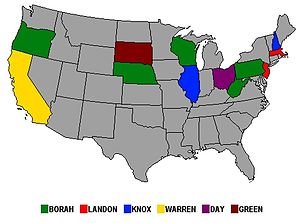1936 Republican National Convention
| 1936 presidential election | |
  Nominees Landon and Knox | |
| Convention | |
|---|---|
| Date(s) | June 9–12, 1936 |
| City | Cleveland, Ohio |
| Venue | Public Auditorium |
| Keynote speaker | Frederick Steiwer U.S. Senator, Oregon[1][2] |
| Candidates | |
| Presidential nominee | Alf Landon of Kansas |
| Vice presidential nominee | Frank Knox of Illinois |
| Other candidates | William Borah of Idaho |
| Results (president) | Landon 984, Borah 19 |
The 1936 Republican National Convention was held June 9–12 at the Public Auditorium in Cleveland, Ohio. It nominated Governor Alfred Landon of Kansas for president and Frank Knox of Illinois for vice president.
The convention supported many New Deal programs, including Social Security. The keynote address was given on June 9 by Frederick Steiwer, U.S. Senator from Oregon.[1][2]

Governor
Alf Landon
of Kansas
Senator
William Borah
of Idaho
Newspaper editor
Frank Knox
of Illinois
Senator
Frederick Steiwer
of Oregon
Former President
Herbert Hoover
of California
Although many candidates sought the Republican nomination, only two, Governor Landon and Senator Borah, were considered to be serious candidates. Although favorite sons County Attorney Earl Warren of California, Governor Warren E. Green of South Dakota, and Stephen A. Day of Ohio won their respective primaries, the 70-year-old Borah, a well-known progressive and "insurgent," carried the Wisconsin, Nebraska, Pennsylvania, West Virginia, and Oregon primaries, while also performing quite strongly in Knox's Illinois and Green's South Dakota. However, the party machinery almost uniformly backed Landon, a wealthy businessman and centrist, who won primaries in Massachusetts and New Jersey and dominated in the caucuses and at state party conventions.
Other potential candidates included Robert A. Taft, New York Representative James W. Wadsworth, Jr., Michigan Senator Arthur Vandenberg, Iowa Senator Lester Dickinson, New York Representative Hamilton Fish III, New Jersey Governor Harold Hoffman, Delaware Governor C. Douglass Buck, Supreme Court Justice Owen Roberts, Michigan auto magnate Henry Ford, aviator Charles Lindbergh, former President Herbert Hoover, Oregon Senator Frederick Steiwer, Senate Minority Leader Charles McNary, former Treasury Secretary Ogden L. Mills and Theodore Roosevelt, Jr., cousin of Democratic incumbent Franklin D. Roosevelt.
At the start of the convention, Landon looked like the likely nominee, but faced opposition from a coalition led by Michigan Senator Arthur Vandenberg, Idaho Senator William E. Borah, and newspaper publisher Frank Knox.[3] However, the stop-Landon movement failed.

The tally of the first ballot at the convention was:
- Alfred Landon, 984
- William Borah, 19
Knox was nominated for vice president.
See also[]
- History of the United States Republican Party
- List of Republican National Conventions
- List of presidential nominating conventions in the United States
- U.S. presidential nomination convention
- 1936 Republican Party presidential primaries
- 1936 United States presidential election
- 1936 Democratic National Convention
References[]
- ^ a b Ferguson, Harry (June 10, 1936). "New Deal rebels wooed by G.O.P." Pittsburgh Press. United Press. p. 1.
- ^ a b "'Return to American system,' keynote advises G.O.P." Pittsburgh Press. United Press. June 10, 1936. p. 7.
- ^ Krock, Arthur (June 10, 1936). "Keynoter Denounces Roosevelt Policies, Demanding Tax Cuts and Balanced Budget; Landon Men Take Control of Convention". The New York Times. Retrieved October 9, 2015.
External links[]
- Republican Party platform of 1936 at The American Presidency Project
| Preceded by 1932 Chicago |
Republican National Conventions | Succeeded by 1940 Philadelphia |
Coordinates: 41°30′14″N 81°41′35″W / 41.504°N 81.693°W
- Republican National Conventions
- 1936 United States presidential election
- 1930s in Cleveland
- 1936 in Ohio
- 1936 conferences
- June 1936 events
- United States politics stubs





